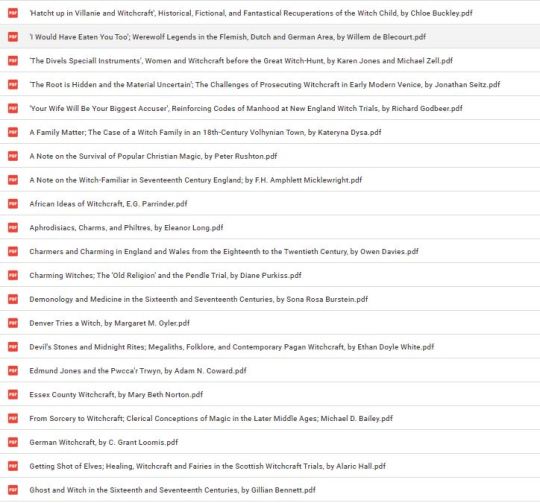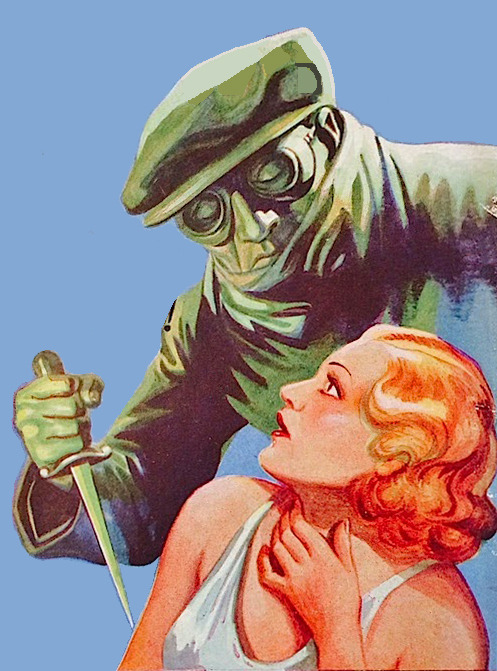#g. p. micklewright
Text

Jack Mann - Maker of Shadows. Wright & Brown Ltd., 1938.
Cover art by G. P. Micklewright.
48 notes
·
View notes
Text

book cover - She Was Sheriff 1940
George Pearce Micklewright
2 notes
·
View notes
Text






JSTOR Articles on the History of Witchcraft, Witch Trials, and Folk Magic Beliefs
This is a partial of of articles on these subjects that can be found in the JSTOR archives. This is not exhaustive - this is just the portion I've saved for my own studies (I've read and referenced about a third of them so far) and I encourage readers and researchers to do their own digging. I recommend the articles by Ronald Hutton, Owen Davies, Mary Beth Norton, Malcolm Gaskill, Michael D. Bailey, and Willem de Blecourt as a place to start.
If you don't have personal access to JSTOR, you may be able to access the archive through your local library, university, museum, or historical society.
Full text list of titles below the cut:
'Hatcht up in Villanie and Witchcraft': Historical, Fiction, and Fantastical Recuperations of the Witch Child, by Chloe Buckley
'I Would Have Eaten You Too': Werewolf Legends in the Flemish, Dutch and German Area, by Willem de Blecourt
'The Divels Special Instruments': Women and Witchcraft before the Great Witch-hunt, by Karen Jones and Michael Zell
'The Root is Hidden and the Material Uncertain': The Challenges of Prosecuting Witchcraft in Early Modern Venice, by Jonathan Seitz
'Your Wife Will Be Your Biggest Accuser': Reinforcing Codes of Manhood at New England Witch Trials, by Richard Godbeer
A Family Matter: The CAse of a Witch Family in an 18th-Century Volhynian Town, by Kateryna Dysa
A Note on the Survival of Popular Christian Magic, by Peter Rushton
A Note on the Witch-Familiar in Seventeenth Century England, by F.H. Amphlett Micklewright
African Ideas of Witchcraft, by E.G. Parrinder
Aprodisiacs, Charms, and Philtres, by Eleanor Long
Charmers and Charming in England and Wales from the Eighteenth to the Twentieth Century, by Owen Davies
Charming Witches: The 'Old Religion' and the Pendle Trial, by Diane Purkiss
Demonology and Medicine in the Sixteenth and Seventeenth Centuries, by Sona Rosa Burstein
Denver Tries A Witch, by Margaret M. Oyler
Devil's Stones and Midnight Rites: Megaliths, Folklore, and Contemporary Pagan Witchcraft, by Ethan Doyle White
Edmund Jones and the Pwcca'r Trwyn, by Adam N. Coward
Essex County Witchcraft, by Mary Beth Norton
From Sorcery to Witchcraft: Clerical Conceptions of Magic in the Later Middle Ages, by Michael D. Bailey
German Witchcraft, by C. Grant Loomis
Getting of Elves: Healing, Witchcraft and Fairies in the Scottish Witchcraft Trials, by Alaric Hall
Ghost and Witch in the Sixteenth and Seventeenth Centuries, by Gillian Bennett
Ghosts in Mirrors: Reflections of the Self, by Elizabeth Tucker
Healing Charms in Use in England and Wales 1700-1950, by Owen Davies
How Pagan Were Medieval English Peasants?, by Ronald Hutton
Invisible Men: The Historian and the Male Witch, by Lara Apps and Andrew Gow
Johannes Junius: Bamberg's Famous Male Witch, by Lara Apps and Andrew Gow
Knots and Knot Lore, by Cyrus L. Day
Learned Credulity in Gianfrancesco Pico's Strix, by Walter Stephens
Literally Unthinkable: Demonological Descriptions of Male Witches, by Lara Apps and Andrew Gow
Magical Beliefs and Practices in Old Bulgaria, by Louis Petroff
Maleficent Witchcraft in Britian since 1900, by Thomas Waters
Masculinity and Male Witches in Old and New England, 1593-1680, by E.J. Kent
Methodism, the Clergy, and the Popular Belief in Witchcraft and Magic, by Owen Davies
Modern Pagan Festivals: A Study in the Nature of Tradition, by Ronald Hutton
Monstrous Theories: Werewolves and the Abuse of History, by Willem de Blecourt
Neapolitan Witchcraft, by J.B. Andrews and James G. Frazer
New England's Other Witch-Hunt: The Hartford Witch-Hunt of the 1660s and Changing Patterns in Witchcraft Prosecution, by Walter Woodward
Newspapers and the Popular Belief in Witchcraft and Magic in the Modern Period, by Owen Davies
Occult Influence, Free Will, and Medical Authority in the Old Bailey, circa 1860-1910, by Karl Bell
Paganism and Polemic: The Debate over the Origins of Modern Pagan Witchcraft, by Ronald Hutton
Plants, Livestock Losses and Witchcraft Accusations in Tudor and Stuart England, by Sally Hickey
Polychronican: Witchcraft History and Children, interpreting England's Biggest Witch Trial, 1612, by Robert Poole
Publishing for the Masses: Early Modern English Witchcraft Pamphlets, by Carla Suhr
Rethinking with Demons: The Campaign against Superstition in Late Medieval and Early Modern Europe from a Cognitive Perspective, by Andrew Keitt
Seasonal Festivity in Late Medieval England, Some Further Reflections, by Ronald Hutton
Secondary Targets: Male Witches on Trial, by Lara Apps and Andrew Gow
Some Notes on Modern Somerset Witch-Lore, by R.L. Tongue
Some Notes on the History and Practice of Witchcraft in the Eastern Counties, by L.F. Newman
Some Seventeenth-Century Books of Magic, by K.M. Briggs
Stones and Spirits, by Jane P. Davidson and Christopher John Duffin
Superstitions, Magic, and Witchcraft, by Jeffrey R. Watt
The 1850s Prosecution of Gerasim Fedotov for Witchcraft, by Christine D. Worobec
The Catholic Salem: How the Devil Destroyed a Saint's Parish (Mattaincourt, 1627-31), by William Monter
The Celtic Tarot and the Secret Tradition: A Study in Modern Legend Making, by Juliette Wood
The Cult of Seely Wights in Scotland, by Julian Goodare
The Decline of Magic: Challenge and Response in Early Enlightenment England, by Michael Hunter
The Devil-Worshippers at the Prom: Rumor-Panic as Therapeutic Magic, by Bill Ellis
The Devil's Pact: Diabolic Writing and Oral Tradition, by Kimberly Ball
The Discovery of Witches: Matthew Hopkins' Defense of his Witch-hunting Methods, by Sheilagh Ilona O'Brien
The Disenchantment of Magic: Spells, Charms, and Superstition in Early European Witchcraft Literature, by Michael D. Bailey
The Epistemology of Sexual Trauma in Witches' Sabbaths, Satanic Ritual Abuse, and Alien Abduction Narratives, by Joseph Laycock
The European Witchcraft Debate and the Dutch Variant, by Marijke Gijswijt-Hofstra
The Flying Phallus and the Laughing Inquisitor: Penis Theft in the Malleus Maleficarum, by Moira Smith
The Framework for Scottish Witch-Hunting for the 1590s, by Julian Goodare
The Imposture of Witchcraft, by Rossell Hope Robbins
The Last Witch of England, by J.B. Kingsbury
The Late Lancashire Witches: The Girls Next Door, by Meg Pearson
The Malefic Unconscious: Gender, Genre, and History in Early Antebellum Witchcraft Narratives, by Lisa M. Vetere
The Mingling of Fairy and Witch Beliefs in Sixteenth and Seventeenth Century Scotland, by J.A. MacCulloch
The Nightmare Experience, Sleep Paralysis, and Witchcraft Accusations, by Owen Davies
The Pursuit of Reality: Recent Research into the History of Witchcraft, by Malcolm Gaskill
The Reception of Reginald Scot's Discovery of Witchcraft: Witchcraft, Magic, and Radical Religions, by S.F. Davies
The Role of Gender in Accusations of Witchcraft: The Case of Eastern Slovenia, by Mirjam Mencej
The Scottish Witchcraft Act, by Julian Goodare
The Werewolves of Livonia: Lycanthropy and Shape-Changing in Scholarly Texts, 1550-1720, by Stefan Donecker
The Wild Hunter and the Witches' Sabbath, by Ronald Hutton
The Winter Goddess: Percht, Holda, and Related Figures, by Lotta Motz
The Witch's Familiar and the Fairy in Early Modern England and Scotland, by Emma Wilby
The Witches of Canewdon, by Eric Maple
The Witches of Dengie, by Eric Maple
The Witches' Flying and the Spanish Inquisitors, or How to Explain Away the Impossible, by Gustav Henningsen
To Accommodate the Earthly Kingdom to Divine Will: Official and Nonconformist Definitions of Witchcraft in England, by Agustin Mendez
Unwitching: The Social and Magical Practice in Traditional European Communities, by Mirjam Mencej
Urbanization and the Decline of Witchcraft: An Examination of London, by Owen Davies
Weather, Prayer, and Magical Jugs, by Ralph Merrifield
Witchcraft and Evidence in Early Modern England, by Malcolm Gaskill
Witchcraft and Magic in the Elizabethan Drama by H.W. Herrington
Witchcraft and Magic in the Rochford Hundred, by Eric Maple
Witchcraft and Old Women in Early Modern Germany, by Alison Rowlands
Witchcraft and Sexual Knowledge in Early Modern England, by Julia M. Garrett
Witchcraft and Silence in Guillaume Cazaux's 'The Mass of Saint Secaire', by William G. Pooley
Witchcraft and the Early Modern Imagination, by Robin Briggs
Witchcraft and the Western Imagination by Lyndal Roper
Witchcraft Belief and Trals in Early Modern Ireland, by Andrew Sneddon
Witchcraft Deaths, by Mimi Clar
Witchcraft Fears and Psychosocial Factors in Disease, by Edward Bever
Witchcraft for Sale, by T.M. Pearce
Witchcraft in Denmark, by Gustav Henningsen
Witchcraft in Germany, by Taras Lukach
Witchcraft in Kilkenny, by T. Crofton Croker
Witchcraft in Anglo-American Colonies, by Mary Beth Norton
Witchcraft in the Central Balkans I: Characteristics of Witches, by T.P. Vukanovic
Witchcraft in the Central Balkans II: Protection Against Witches, by T.P. Vukanovic
Witchcraft Justice and Human Rights in Africa, Cases from Malawi, by Adam Ashforth
Witchcraft Magic and Spirits on the Border of Pennsylvania and West Virginia, by S.P. Bayard
Witchcraft Persecutions in the Post-Craze Era: The Case of Ann Izzard of Great Paxton, 1808, by Stephen A. Mitchell
Witchcraft Prosecutions and the Decline of Magic, by Edward Bever
Witchcraft, by Ray B. Browne
Witchcraft, Poison, Law, and Atlantic Slavery, by Diana Paton
Witchcraft, Politics, and Memory in Seventeeth-Century England, by Malcolm Gaskill
Witchcraft, Spirit Possession and Heresy, by Lucy Mair
Witchcraft, Women's Honour and Customary Law in Early Modern Wales, by Sally Parkin
Witches and Witchbusters, by Jacqueline Simpson
Witches, Cunning Folk, and Competition in Denmark, by Timothy R. Tangherlini
Witches' Herbs on Trial, by Michael Ostling
#witchcraft#witchblr#history#history of witchcraft#occult#witch trials#research#recommended reading#book recs#jstor
2K notes
·
View notes
Text
Motivational Videos
What is motivation?
Motivation is the desire to do something willingly and a reason for behaving in a certain way. Ryan and Deci (2000) state three categories for motivation these are amotivation, extrinsic and intrinsic motivation. All of which split off into separate sub categories in their respective broad categories.
Interventions for motivation:
Mellalieu, Hanton and Thomas (2009) emphasize that pre game imagery interventions have positive effects on the athlete’s anxiety and self-confidence. In addition, Wolframm et al. (2011) states preperformance imagery interventions which include being in tough situations result in the athlete having higher self-confidence levels due to being mentally tougher.
The above interventions are good examples to improve athletes intrinsic motivation for performance. One way to improve this intrinsic motivation is through motivational videos.
Motivational videos are said to improve the understanding of the athletes performance, increase self confidence, team confidence and motivate athletes for upcoming games (Jenkins, Morgan, & O’Donoghue, 2007). Barwood, Weston, Thelwell and Page (2009) suggest these motivational videos or tracks include a high tempo track which enhance the energy of the athlete and bring the onset of bodily action. Furthermore, Jenkins et al. (2007) suggests these videos contain positive performances of the individual’s and are shown before the game to improve motivation.
Other Uses of Motivation:
O’Donoghue (2006) highlights several other uses of motivation which are listed below:
Tournament movie
Career movie to celebrate appearances of a player
Pre Final/Big game
Man of the match or weekly videos
Motivational Player Clips
Pre Season Camps
These examples are ones to which motivational videos can be shown to in order for athletes to increase in confidence and motivation.
When to show a Motivational Video?
Jenkins et al. (2007) demonstrates the best time to show one of these videos is half an hour before competition or matches. This timing is key as it will allow the athlete’s to reach the correct level of motivation and confidence to improve performances during matches.
Benefits of Motivational Videos:
Jenkins et al. (2007) suggests many benefits of showing these videos to athletes before competition these are listed below:
Motivates athlete’s for games
Improves self-confidence
Improves team confidence
Improves team spirit.
These are only a few benefit to what a motivational video can achieve when shown to athletes.
An example of a motivational which I created for Manchester United will be shown below:
https://web.microsoftstream.com/video/5dafef4d-fd89-4f28-99a7-5325132ef1ca
References:
Barwood, M. J., Weston, N. J. V., Thelwell, R., & Page, J. (2009). A motivational music and video intervention improves high-intensity exercise performance. Journal of Sports Science and Medicine, 8(3), 435–442.
Jenkins, E. R., Morgan, L., & O’Donoghue, P. (2007). A case study into the effectiveness of computerised match analysis and motivational videos within the coaching of a league netball team. International Journal of Performance Analysis in Sport, 7(2), 59–80. https://doi.org/10.1080/24748668.2007.11868397
Mellalieu, S. D., Hanton, S., & Thomas, O. (2009). The effects of a motivational general-arousal imagery intervention upon preperformance symptoms in male rugby union players. Psychology of Sport and Exercise, 10(1), 175–185. https://doi.org/10.1016/j.psychsport.2008.07.003
O’Donoghue, P. (2006). The use of feedback videos in sport. International Journal of Performance Analysis in Sport, 6(2), 1–14. https://doi.org/10.1080/24748668.2006.11868368
Vallerand, R. J. (2000). Deci and Ryan ’ s Self-Determination Theory : A View from the Hierarchical Model of Intrinsic and Extrinsic Motivation Author ( s ): Robert J . Vallerand REFERENCES Linked references are available on JSTOR for this article : reference # references _ tab _. Psychological Inquiry, 11(4), 312–318.
Wolframm, I. a., Micklewright, D., Wilson, M. R., Smith, N. C., Holmes, P. S., Wood, G., … Lonsdale, C. (2011). The Effect of Mental Imagery upon the Reduction of Athletes ` Anxiety during Sport Performance. Psychology of Sport and Exercise, 20(February 2015), 623–635. Retrieved from http://content.ebscohost.com/ContentServer.asp?T=P&P=AN&K=62850536&S=R&D=aph&EbscoContent=dGJyMNHr7ESeprQ4zOX0OLCmr0mep7VSsKi4SLCWxWXS&ContentCustomer=dGJyMPGts0mxr7FMuePfgeyx44Dt6fIA%5Cnhttps://ezproxy.taylor.edu/login?url=http://search.ebscohost.com/login
0 notes
Photo

1933 Black Beauty by Anna Sewell #illustrated by G. P. Micklewright - [ ] #antiquarian #illustration_daily #bookshelf #antiquarianbookshop #americanantiquarian #illustration #illustrations #booksbooksbooks #childrenseemagic #childrensbooks #books #illustrationart #illustrationartists #bookshelves #childrensbook #childrensfashion #bookstore #childrens #antiquarianbook #books📚 #illustrationartist #antiquarianbooks #bookstagram #blackbeauty #annasewell #gpmicklewright https://www.instagram.com/p/B467A_hpl-k/?igshid=8dvbsd072a28
#illustrated#antiquarian#illustration_daily#bookshelf#antiquarianbookshop#americanantiquarian#illustration#illustrations#booksbooksbooks#childrenseemagic#childrensbooks#books#illustrationart#illustrationartists#bookshelves#childrensbook#childrensfashion#bookstore#childrens#antiquarianbook#books📚#illustrationartist#antiquarianbooks#bookstagram#blackbeauty#annasewell#gpmicklewright
0 notes
Text

book cover - The Ghost Man 1936
George Pearce Micklewright
#golden age art#book cover art#pulp art#pulp art 1936#The Ghost Man#G P Micklewright art#byronrimbaud
2 notes
·
View notes
Text
Reference List:
References:
Barwood, M. J., Weston, N. J. V., Thelwell, R., & Page, J. (2009). A motivational music and video intervention improves high-intensity exercise performance. Journal of Sports Science and Medicine, 8(3), 435–442.
Barron, D., Ball, G., Robins, M., & Sunderland, C. (2018). Artificial neural networks and player recruitment in professional soccer. PLoS ONE, 13(10), 1–11. https://doi.org/10.1371/journal.pone.0205818
Hughes, M., & Franks, I. M. (Eds.). (2004). Notational analysis of sport: Systems for better coaching and performance in sport. Psychology Press.
Bourdon, P. C., Cardinale, M., Murray, A., Gastin, P., Kellmann, M., Varley, M. C. Cable, N. T. (2017). Monitoring athlete training loads: Consensus statement. International Journal of Sports Physiology and Performance, 12, 161–170. https://doi.org/10.1123/IJSPP.2017-0208
Butler, R. J., & Hardy, L. (2016). The Performance Profile: Theory and Application. The Sport Psychologist, 6(3), 253–264. https://doi.org/10.1123/tsp.6.3.253
Butterworth, A., O’Donoghue, P., & Cropley, B. (2013). Performance profiling in sports coaching: A review. International Journal of Performance Analysis in Sport, 13(3), 572–593. https://doi.org/10.1080/24748668.2013.11868672
Carling, C., Reilly, T. and Williams, A.M. (2009). Performance Assessment for Field Sports, London: Routledge.
Dowrick, P.W. (1991). Practical guide to using video in behavioural sciences. In T. Reilly, J. Hughes and M. Hughes (Eds.), Science and Football III (pp. 267-278). London, UK: E & FN Spon.
Franks, I.M. and Miller, G. (1991). ‘Training coaches to observe and remember’, Journal of Sports Sciences, 9: 285–97.
Gabbett, T. J., Nassis, G. P., Oetter, E., Pretorius, J., Johnston, N., Medina, D., … Ryan, A. (2017). The athlete monitoring cycle: A practical guide to interpreting and applying training monitoring data. British Journal of Sports Medicine, 51(20), 1451–1452. https://doi.org/10.1136/bjsports-2016-097298
Groom, R., & Cushion, C. (2005). Using of Video Based Coaching With Players: A Case Study. International Journal of Performance Analysis in Sport, 5(3), 40–46. https://doi.org/10.1080/24748668.2005.11868336
Groom, R., Cushion, C., & Nelson, L. (2011). The delivery of video-based performance analysis by england youth soccer coaches: Towards a grounded theory. Journal of Applied Sport Psychology, 23(1), 16–32. https://doi.org/10.1080/10413200.2010.511422
Høigaard, R., Säfvenbom, R., & Tønnessen, F. E. (2006). The relationship between group cohesion, group norms, and perceived social loafing in soccer teams. Small group research, 37(3), 217-232.
Hughes, M. D., & Bartlett, R. M. (2002). The use of performance indicators in performance analysis. / Utilisation des indicateurs de performance pour l ’ analyse de cette performance. Journal of Sports Sciences, 20(10), 739–754. Retrieved from http://articles.sirc.ca/search.cfm?id=S-847006%5Cnhttp://www.tandf.co.uk/journals%5Cnhttp://search.ebscohost.com/login.aspx?direct=true&db=s3h&AN=SPHS-847006&site=ehost-live
Hughes, M., Caudrelier, T., James, N., Redwood-Brown, A., Donnelly, I., Kirkbride, A., & Duschesne, C. (2012). Moneyball and soccer - An analysis of the key performance indicators of elite male soccer players by position. Journal of Human Sport and Exercise, 7(SPECIALISSUE.2), 402–412. https://doi.org/10.4100/jhse.2012.72.06
Hughes, M & I, Franks. (2018). Analysis of Notation Data. Essentials of Performance Analysis in Sport, 169–179. https://doi.org/10.4324/9781315776743-11
Jenkins, E. R., Morgan, L., & O’Donoghue, P. (2007). A case study into the effectiveness of computerised match analysis and motivational videos within the coaching of a league netball team. International Journal of Performance Analysis in Sport, 7(2), 59–80. https://doi.org/10.1080/24748668.2007.11868397
Kolb, D. A. (1984). Experiential Learning: Experience as The Source of Learning and Development. Prentice Hall, Inc., (1984), 20–38. https://doi.org/10.1016/B978-0-7506-7223-8.50017-4
Krenn, B., Würth, S., & Hergovich, A. (2013). The impact of feedback on goal setting and task performance: Testing the feedback intervention theory. Swiss Journal of Psychology, 72(2), 79–89. https://doi.org/10.1024/1421-0185/a000101
Lyons, K. (1988). Using video in sport, Huddersfield: Springfield Books.
Mackenzie, R., & Cushion, C. (2013). Performance analysis in football: A critical review and implications for future research. Journal of Sports Sciences, 31(6), 639–676. https://doi.org/10.1080/02640414.2012.746720
Mellalieu, S. D., Hanton, S., & Thomas, O. (2009). The effects of a motivational general-arousal imagery intervention upon preperformance symptoms in male rugby union players. Psychology of Sport and Exercise, 10(1), 175–185. https://doi.org/10.1016/j.psychsport.2008.07.003
O’Donoghue, P. (2006). The use of feedback videos in sport. International Journal of Performance Analysis in Sport, 6(2), 1–14. https://doi.org/10.1080/24748668.2006.11868368
O’Donoghue, P. (2009). Research methods for sports performance analysis. In Research Methods for Sports Performance Analysis. https://doi.org/10.4324/9780203878309
Rossi, A., Perri, E., Trecroci, A., Savino, M., Alberti, G., & Iaia, F. M. (2017). GPS data reflect players’ internal load in soccer. IEEE International Conference on Data Mining Workshops, ICDMW, 2017-November, 890–893. https://doi.org/10.1109/ICDMW.2017.122
Ryan, S., Kempton, T., & Coutts, A. J. (2020). Data Reduction Approaches to Athlete Monitoring in Professional Australian Football. International Journal of Sports Physiology and Performance, 1–7. https://doi.org/10.1123/ijspp.2020-0083
Saw, A. E., Main, L. C., & Gastin, P. B. (2016). Monitoring the athlete training response: Subjective self-reported measures trump commonly used objective measures: A systematic review. British Journal of Sports Medicine, 50(5), 281–291. https://doi.org/10.1136/bjsports-2015-094758
Schank, R. C., Berman, T. R., & Macpherson, K. A. (2013). Learning by doing. In Instructional-Design Theories and Models: A New Paradigm of Instructional Theory (Vol. 2). https://doi.org/10.4324/9781410603784-14
Stoeber, J., Otto, K., Pescheck, E., Becker, C., & Stoll, O. (2007). Stoeber, J., Otto, K., Pescheck, E., Becker, C., & Stoll, O. (2007). Perfectionism and competitive anxiety in athletes: Differentiating striving for perfection and negative reactions to imperfection. 959–969.
Thornton, H. R., Delaney, J. A., Duthie, G. M., & Dascombe, B. J. (2019). Developing athlete monitoring systems in team sports: Data analysis and visualization. International Journal of Sports Physiology and Performance, 14(6), 698–705. https://doi.org/10.1123/ijspp.2018-0169
Underwood, G. and MacHeath, J. (1977). Video analysis in tennis coaching, British Journal of Physical Education, 8, 136-138.7
Vallerand, R. J. (2000). Deci and Ryan ’ s Self-Determination Theory : A View from the Hierarchical Model of Intrinsic and Extrinsic Motivation Author ( s ): Robert J . Vallerand REFERENCES Linked references are available on JSTOR for this article : reference # references _ tab _. Psychological Inquiry, 11(4), 312–318.
Wolframm, I. a., Micklewright, D., Wilson, M. R., Smith, N. C., Holmes, P. S., Wood, G., … Lonsdale, C. (2011). The Effect of Mental Imagery upon the Reduction of Athletes ` Anxiety during Sport Performance. Psychology of Sport and Exercise, 20(February 2015), 623–635. Retrieved from http://content.ebscohost.com/ContentServer.asp?T=P&P=AN&K=62850536&S=R&D=aph&EbscoContent=dGJyMNHr7ESeprQ4zOX0OLCmr0mep7VSsKi4SLCWxWXS&ContentCustomer=dGJyMPGts0mxr7FMuePfgeyx44Dt6fIA%5Cnhttps://ezproxy.taylor.edu/login?url=http://search.ebscohost.com/login
Wright, C., Atkins, S., & Jones, B. (2012). An analysis of elite coaches’ engagement with performance analysis services (match, notational analysis and technique analysis). International Journal of Performance Analysis in Sport, 12(2), 436–451. https://doi.org/10.1080/24748668.2012.11868609
Wright, C., Atkins, S., Jones, B., & Todd, J. (2013). The role of performance analysts within the coaching process: Performance Analysts Survey “The role of performance analysts in elite football club settings.” International Journal of Performance Analysis in Sport, 13(1), 240–261. https://doi.org/10.1080/24748668.2013.11868645
Wright, C., Carling, C., Lawlor, C., & Collins, D. (2016). Elite football player engagement with performance analysis. International Journal of Performance Analysis in Sport, 16(3), 1007–1032. https://doi.org/10.1080/24748668.2016.118689
0 notes
Text
Motivational Vidoes
What is motivation?
Motivation is the desire to do something willingly and a reason for behaving in a certain way. Ryan and Deci (2000) state three categories for motivation these are amotivation, extrinsic and intrinsic motivation. All of which split off into separate sub categories in their respective broad categories.
Interventions for motivation:
Mellalieu, Hanton and Thomas (2009) emphasize that pre game imagery interventions have positive effects on the athlete’s anxiety and self-confidence. In addition, Wolframm et al. (2011) states preperformance imagery interventions which include being in tough situations result in the athlete having higher self-confidence levels due to being mentally tougher.
The above interventions are good examples to improve athletes intrinsic motivation for performance. One way to improve this intrinsic motivation is through motivational videos.
Motivational videos are said to improve the understanding of the athletes performance, increase self confidence, team confidence and motivate athletes for upcoming games (Jenkins, Morgan, & O’Donoghue, 2007). Barwood, Weston, Thelwell and Page (2009) suggest these motivational videos or tracks include a high tempo track which enhance the energy of the athlete and bring the onset of bodily action. Furthermore, Jenkins et al. (2007) suggests these videos contain positive performances of the individual’s and are shown before the game to improve motivation.
Other Uses of Motivation:
O’Donoghue (2006) highlights several other uses of motivation which are listed below:
· Tournament movie
· Career movie to celebrate appearances of a player
· Pre Final/Big game
· Man of the match or weekly videos
· Motivational Player Clips
· Pre Season Camps
These examples are ones to which motivational videos can be shown to in order for athletes to increase in confidence and motivation.
When to show a Motivational Video?
Jenkins et al. (2007) demonstrates the best time to show one of these videos is half an hour before competition or matches. This timing is key as it will allow the athlete’s to reach the correct level of motivation and confidence to improve performances during matches.
Benefits of Motivational Videos:
Jenkins et al. (2007) suggests many benefits of showing these videos to athletes before competition these are listed below:
· Motivates athlete’s for games
· Improves self-confidence
· Improves team confidence
· Improves team spirit.
These are only a few benefit to what a motivational video can achieve when shown to athletes.
An example of a motivational which I created for Manchester United will be shown below:
https://web.microsoftstream.com/video/5dafef4d-fd89-4f28-99a7-5325132ef1ca
References:
Barwood, M. J., Weston, N. J. V., Thelwell, R., & Page, J. (2009). A motivational music and video intervention improves high-intensity exercise performance. Journal of Sports Science and Medicine, 8(3), 435–442.
Jenkins, E. R., Morgan, L., & O’Donoghue, P. (2007). A case study into the effectiveness of computerised match analysis and motivational videos within the coaching of a league netball team. International Journal of Performance Analysis in Sport, 7(2), 59–80. https://doi.org/10.1080/24748668.2007.11868397
Mellalieu, S. D., Hanton, S., & Thomas, O. (2009). The effects of a motivational general-arousal imagery intervention upon preperformance symptoms in male rugby union players. Psychology of Sport and Exercise, 10(1), 175–185. https://doi.org/10.1016/j.psychsport.2008.07.003
O’Donoghue, P. (2006). The use of feedback videos in sport. International Journal of Performance Analysis in Sport, 6(2), 1–14. https://doi.org/10.1080/24748668.2006.11868368
Vallerand, R. J. (2000). Deci and Ryan ’ s Self-Determination Theory : A View from the Hierarchical Model of Intrinsic and Extrinsic Motivation Author ( s ): Robert J . Vallerand REFERENCES Linked references are available on JSTOR for this article : reference # references _ tab _. Psychological Inquiry, 11(4), 312–318.
Wolframm, I. a., Micklewright, D., Wilson, M. R., Smith, N. C., Holmes, P. S., Wood, G., … Lonsdale, C. (2011). The Effect of Mental Imagery upon the Reduction of Athletes ` Anxiety during Sport Performance. Psychology of Sport and Exercise, 20(February 2015), 623–635. Retrieved from http://content.ebscohost.com/ContentServer.asp?T=P&P=AN&K=62850536&S=R&D=aph&EbscoContent=dGJyMNHr7ESeprQ4zOX0OLCmr0mep7VSsKi4SLCWxWXS&ContentCustomer=dGJyMPGts0mxr7FMuePfgeyx44Dt6fIA%5Cnhttps://ezproxy.taylor.edu/login?url=http://search.ebscohost.com/login
0 notes